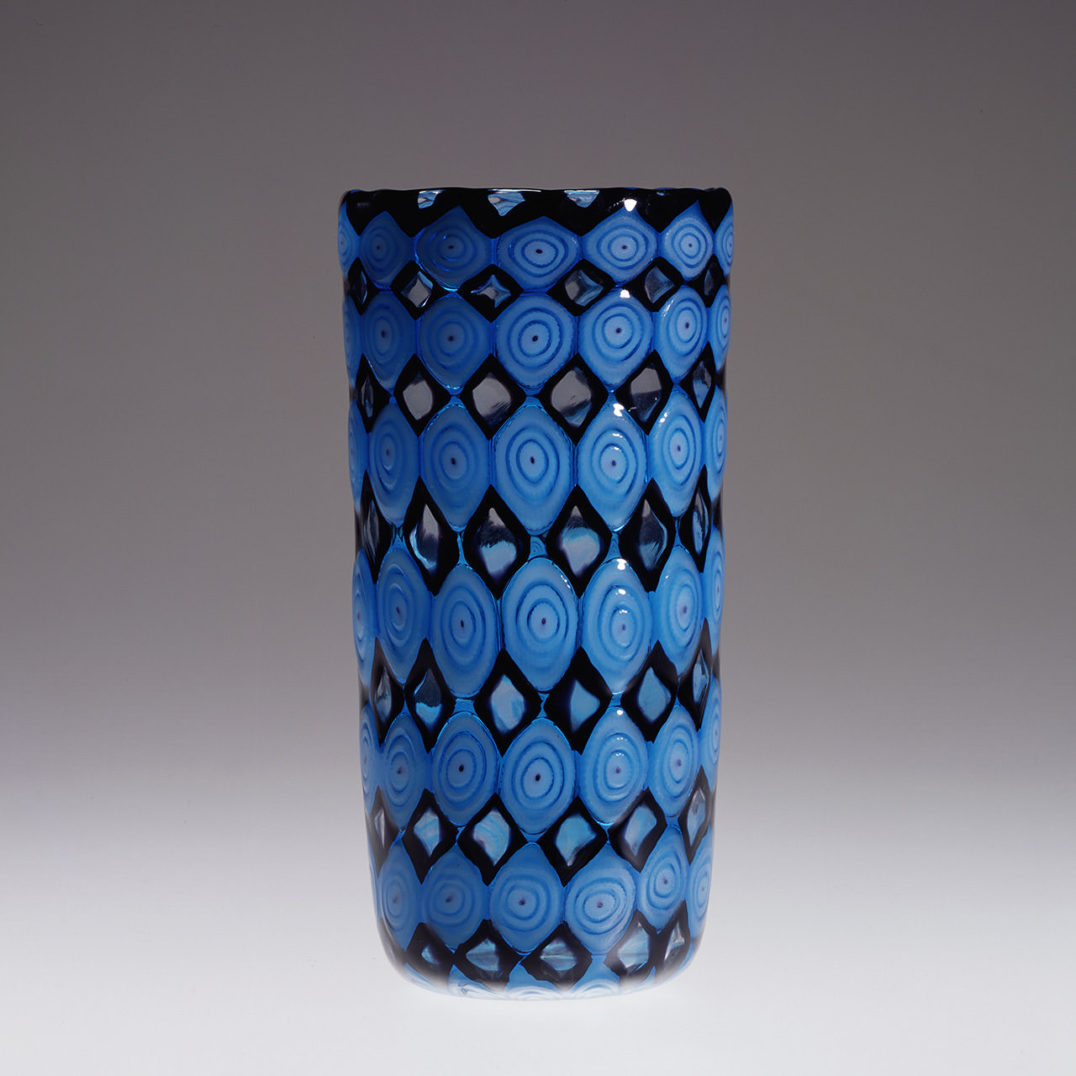
Ermanno TosoCaccia, 1984
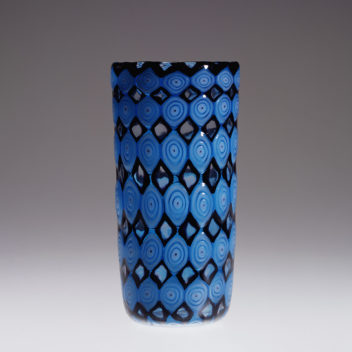
Ermanno TosoCacciaBarovier & Toso, 1984
Cylindrical vase composed of two alternating glass bands. One band is made of circular cristallo, lattimoand blue tessere, the other is Diamond-shaped cristalloand black tessere.
9 in. high (23 cm)
Bibliography and comparative texts:
R. Linzeler, 1922, p. 666;
C. Carrà, 1923, p. 67;
R. Linzeler, 1923, p. 83;
R. Papini, 1930, n. 570;
G. Mariacher, 1967, p. 98;
R. Barovier Mentasti, 1982, n. 252;
Mille anni…, 1982, n. 503;
F. Deboni, 1984, p. n. 70;
W. Neuwirth, 1987, nn. 7, 104;
A. Dorigato, 1986, p. 71;
F. Deboni, 1989, n. 1;
L’arte del vetro, 1982, n. 307;
M. Heiremans, 1993, n. 191;
M. Barovier, R. Barovier Mentasti,
A. Dorigato, 1995, n. 15;
A. Venini Diaz de Santillana, 1996, n. 1;
R. Barovier Mentasti, 1998, n. 25;
A. Venini Diaz de Santillana, 2000, n. 1;
Olnick Spanu, 2000, n. 8;
Olnick Spanu, 2001, n. 13.
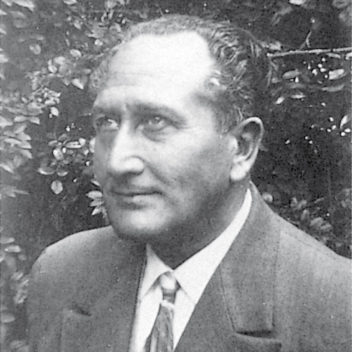
Ermanno Toso 1903–1973
Born on Murano, Ermanno Toso began to work at the Fratelli Toso workshop in 1924, where he was later to become a partner. In 1936, he was named artistic and marketing director of the company. During the period preceding World War II, he created thick glass pieces using traditional decorative techniques that were characterized by simple and solid shapes inspired by the Novecento style. During the '50s, he created a collection of extraordinarily lightweight glass pieces based on a modern interpretation of classical techniques, such as filigrana and murrina. During the '60s, his creative talent led him towards an absolute multicolored sobriety.
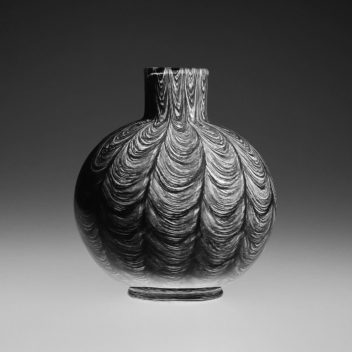
Barovier & Toso 1942–
In 1936, Ercole Barovier became partner of the S.A.I.A.R. Ferro Toso, forming Ferro Toso e Barovier. In 1939, it became Barovier Toso & C., and finally, in 1942, its name was changed to Barovier & Toso. Ercole Barovier remained artistic director of the company through 1972 and was succeeded by his son, Angelo, who was already a designer for the company. Beginning in the '80s and continuing through today, many have designers collaborated with Barovier & Toso. Among them are Matteo Thun, Toni Zuccheri, Renato and Giusto Toso, and Noti Massari. The company’s most recent productions have been created by designers like Roberto Caddeo, Marco Mencacci, Franco Raggi, Luca Scacchetti, and others. Barovier & Toso is currently directed by Angelo, his son Jacopo, and Giovanni Toso.
Ermanno TosoCaccia, 1984
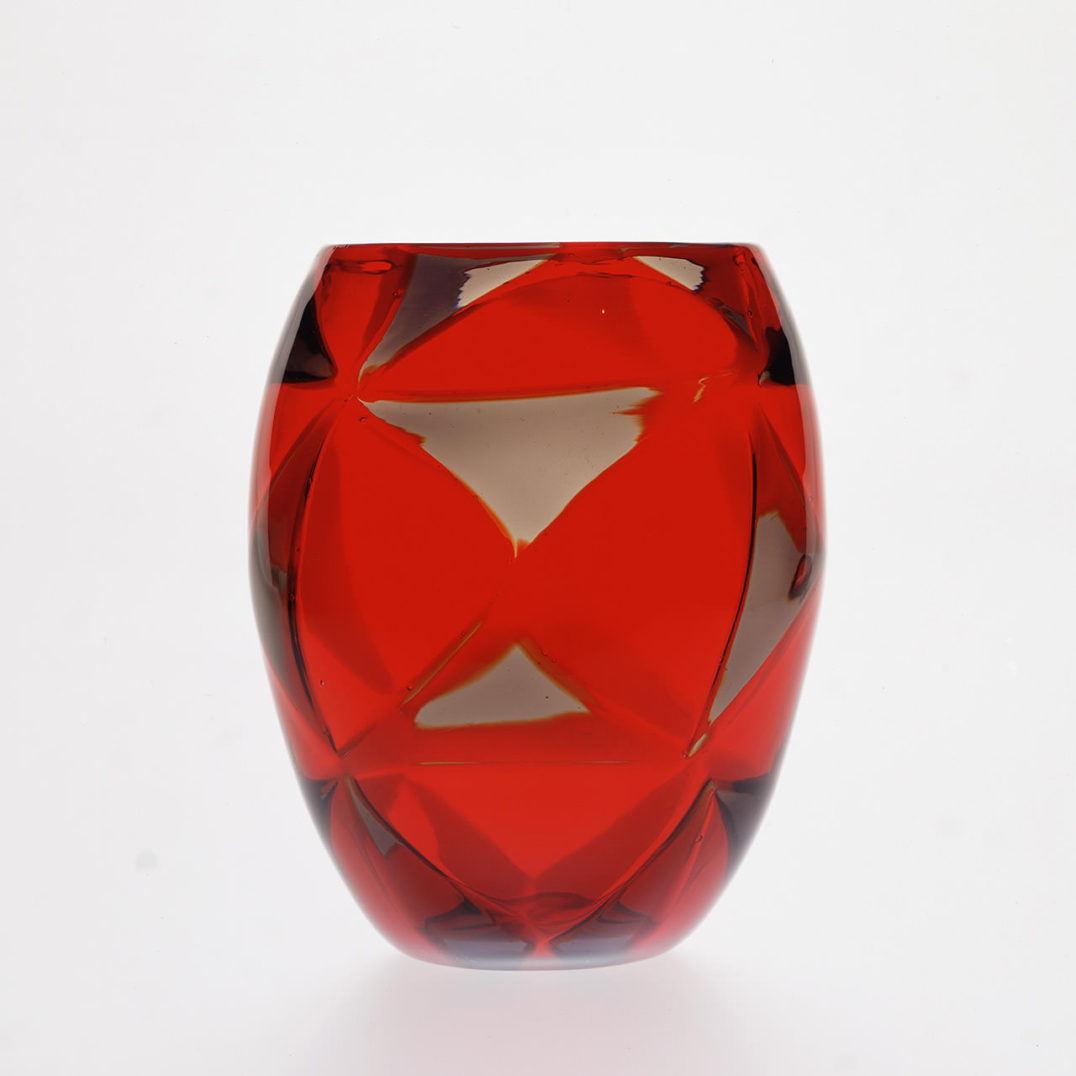
Ermanno TosoIntarsio, 1961–1963
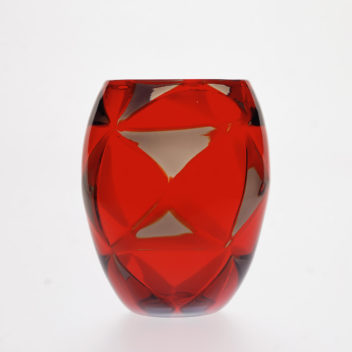
Ermanno TosoIntarsioBarovier & Toso, 1961–1963
Vase composed of grey and red triangular shaped transparent glass patchessommersi in cristallo.
12 in. high (30 cm)
Bibliography and comparative texts:
R. Linzeler, 1922, p. 666;
C. Carrà, 1923, p. 67;
R. Linzeler, 1923, p. 83;
R. Papini, 1930, n. 570;
G. Mariacher, 1967, p. 98;
R. Barovier Mentasti, 1982, n. 252;
Mille anni…, 1982, n. 503;
F. Deboni, 1984, p. n. 70;
W. Neuwirth, 1987, nn. 7, 104;
A. Dorigato, 1986, p. 71;
F. Deboni, 1989, n. 1;
L’arte del vetro, 1982, n. 307;
M. Heiremans, 1993, n. 191;
M. Barovier, R. Barovier Mentasti,
A. Dorigato, 1995, n. 15;
A. Venini Diaz de Santillana, 1996, n. 1;
R. Barovier Mentasti, 1998, n. 25;
A. Venini Diaz de Santillana, 2000, n. 1;
Olnick Spanu, 2000, n. 8;
Olnick Spanu, 2001, n. 13.

Ermanno Toso 1903–1973
Born on Murano, Ermanno Toso began to work at the Fratelli Toso workshop in 1924, where he was later to become a partner. In 1936, he was named artistic and marketing director of the company. During the period preceding World War II, he created thick glass pieces using traditional decorative techniques that were characterized by simple and solid shapes inspired by the Novecento style. During the '50s, he created a collection of extraordinarily lightweight glass pieces based on a modern interpretation of classical techniques, such as filigrana and murrina. During the '60s, his creative talent led him towards an absolute multicolored sobriety.

Barovier & Toso 1942–
In 1936, Ercole Barovier became partner of the S.A.I.A.R. Ferro Toso, forming Ferro Toso e Barovier. In 1939, it became Barovier Toso & C., and finally, in 1942, its name was changed to Barovier & Toso. Ercole Barovier remained artistic director of the company through 1972 and was succeeded by his son, Angelo, who was already a designer for the company. Beginning in the '80s and continuing through today, many have designers collaborated with Barovier & Toso. Among them are Matteo Thun, Toni Zuccheri, Renato and Giusto Toso, and Noti Massari. The company’s most recent productions have been created by designers like Roberto Caddeo, Marco Mencacci, Franco Raggi, Luca Scacchetti, and others. Barovier & Toso is currently directed by Angelo, his son Jacopo, and Giovanni Toso.
Ermanno TosoIntarsio, 1961–1963
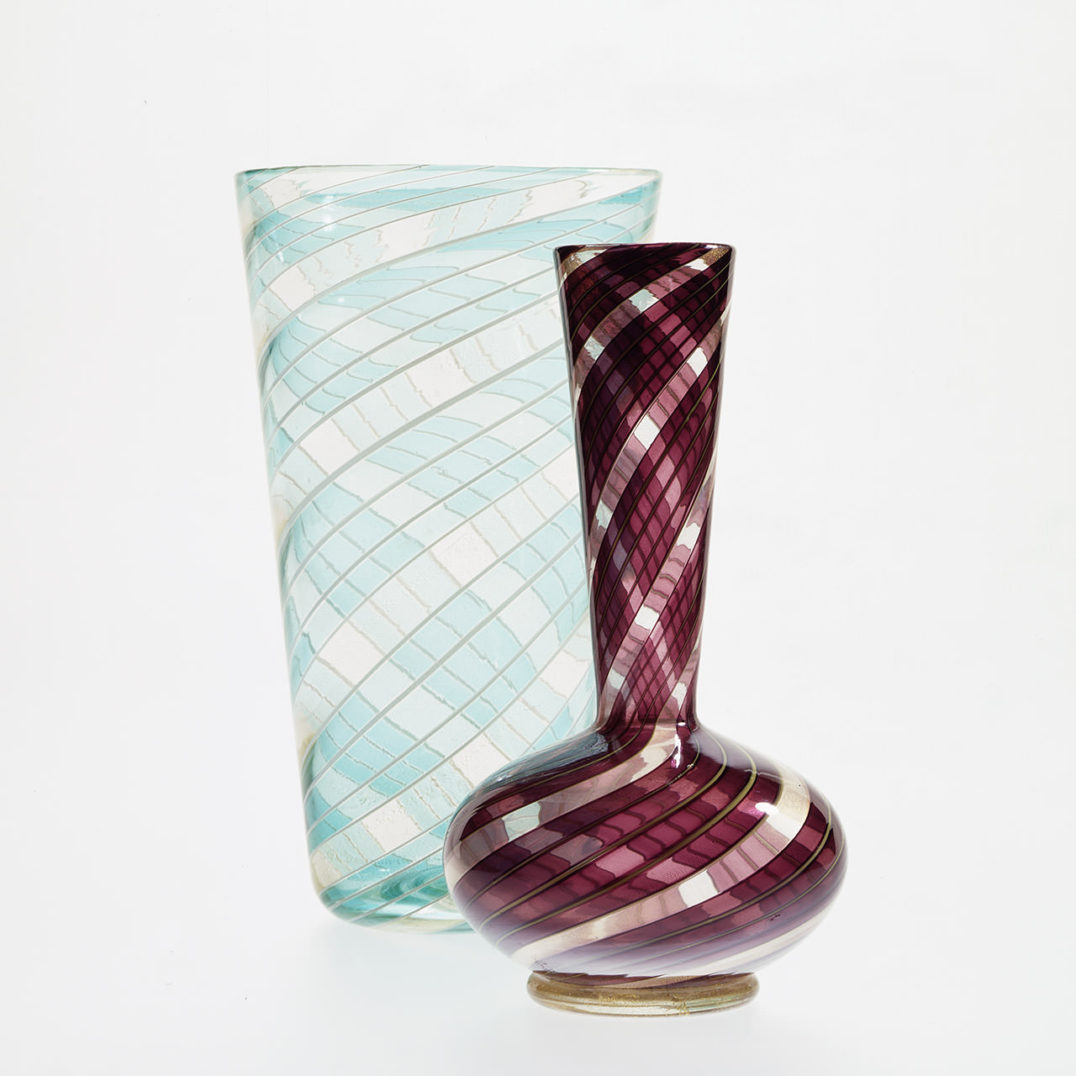
Ermanno TosoNeolitico, 1954
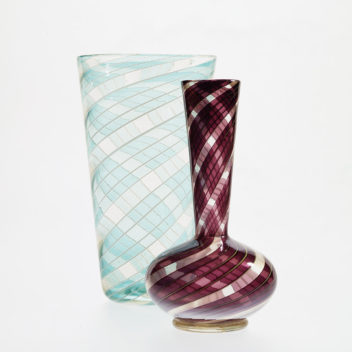
Ermanno TosoNeoliticoBarovier & Toso, 1954
Two tall glass vessels. The vessel on the left is composed of intersectingcristallo and aquamarine canes; the vessel on the right is composed of intersecting cristallo and amethyst canes.
16 in. high (41 cm)
14 in. high (36 cm)
Bibliography and comparative texts:
R. Linzeler, 1922, p. 666;
C. Carrà, 1923, p. 67;
R. Linzeler, 1923, p. 83;
R. Papini, 1930, n. 570;
G. Mariacher, 1967, p. 98;
R. Barovier Mentasti, 1982, n. 252;
Mille anni…, 1982, n. 503;
F. Deboni, 1984, p. n. 70;
W. Neuwirth, 1987, nn. 7, 104;
A. Dorigato, 1986, p. 71;
F. Deboni, 1989, n. 1;
L’arte del vetro, 1982, n. 307;
M. Heiremans, 1993, n. 191;
M. Barovier, R. Barovier Mentasti,
A. Dorigato, 1995, n. 15;
A. Venini Diaz de Santillana, 1996, n. 1;
R. Barovier Mentasti, 1998, n. 25;
A. Venini Diaz de Santillana, 2000, n. 1;
Olnick Spanu, 2000, n. 8;
Olnick Spanu, 2001, n. 13.

Ermanno Toso 1903–1973
Born on Murano, Ermanno Toso began to work at the Fratelli Toso workshop in 1924, where he was later to become a partner. In 1936, he was named artistic and marketing director of the company. During the period preceding World War II, he created thick glass pieces using traditional decorative techniques that were characterized by simple and solid shapes inspired by the Novecento style. During the '50s, he created a collection of extraordinarily lightweight glass pieces based on a modern interpretation of classical techniques, such as filigrana and murrina. During the '60s, his creative talent led him towards an absolute multicolored sobriety.

Barovier & Toso 1942–
In 1936, Ercole Barovier became partner of the S.A.I.A.R. Ferro Toso, forming Ferro Toso e Barovier. In 1939, it became Barovier Toso & C., and finally, in 1942, its name was changed to Barovier & Toso. Ercole Barovier remained artistic director of the company through 1972 and was succeeded by his son, Angelo, who was already a designer for the company. Beginning in the '80s and continuing through today, many have designers collaborated with Barovier & Toso. Among them are Matteo Thun, Toni Zuccheri, Renato and Giusto Toso, and Noti Massari. The company’s most recent productions have been created by designers like Roberto Caddeo, Marco Mencacci, Franco Raggi, Luca Scacchetti, and others. Barovier & Toso is currently directed by Angelo, his son Jacopo, and Giovanni Toso.
Ermanno TosoNeolitico, 1954
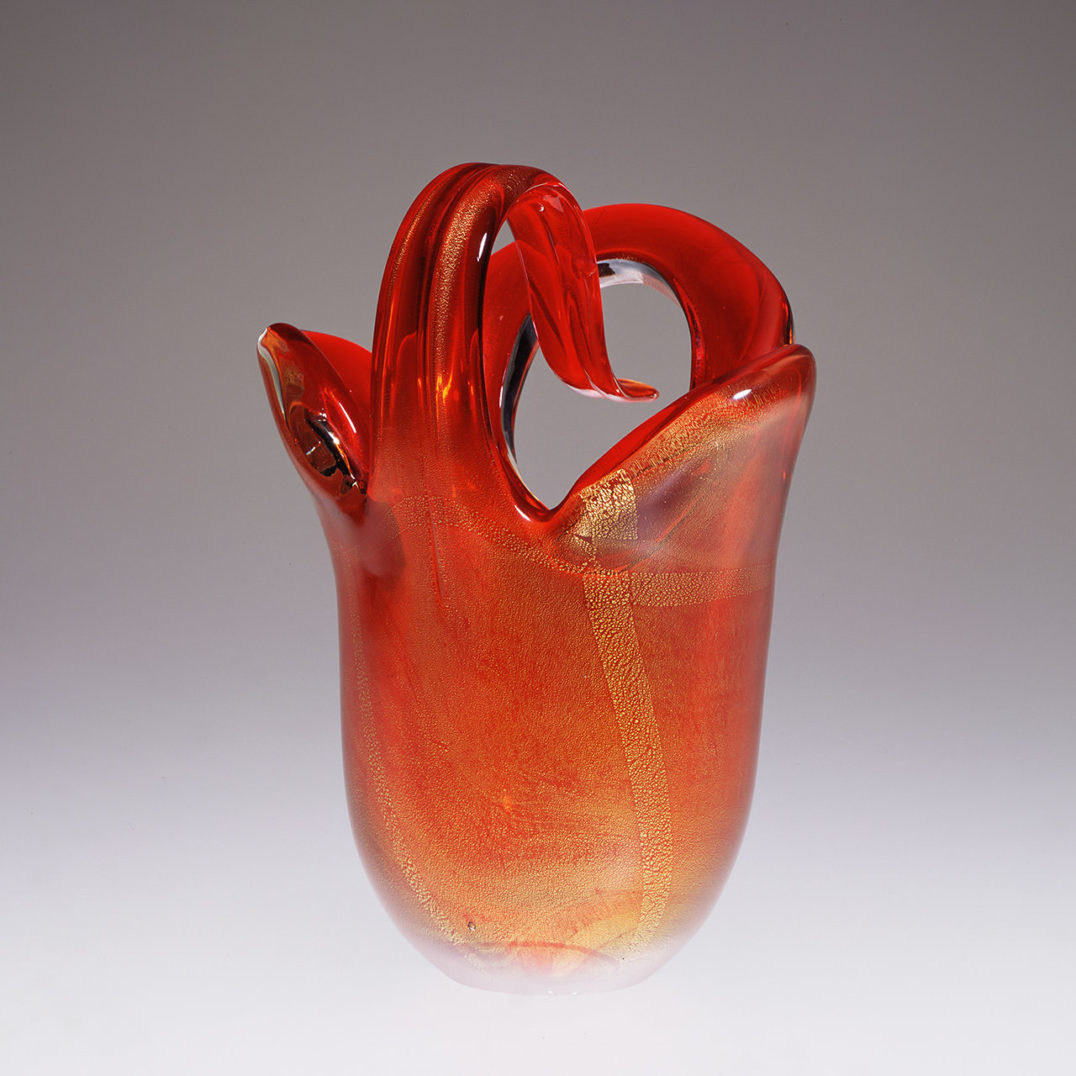
Archimede SegusoSfumato, 1954

Archimede SegusoSfumatoVetreria Archimede Seguso, 1954
A vessel in transparent red glass with one large aperture, two side lips and a stylized handle; inclusions of gold leaf throughout.
11 1/2 in. high (29 cm)
Bibliography and comparative texts:
R. Linzeler, 1922, p. 666;
C. Carrà, 1923, p. 67;
R. Linzeler, 1923, p. 83;
R. Papini, 1930, n. 570;
G. Mariacher, 1967, p. 98;
R. Barovier Mentasti, 1982, n. 252;
Mille anni…, 1982, n. 503;
F. Deboni, 1984, p. n. 70;
W. Neuwirth, 1987, nn. 7, 104;
A. Dorigato, 1986, p. 71;
F. Deboni, 1989, n. 1;
L’arte del vetro, 1982, n. 307;
M. Heiremans, 1993, n. 191;
M. Barovier, R. Barovier Mentasti,
A. Dorigato, 1995, n. 15;
A. Venini Diaz de Santillana, 1996, n. 1;
R. Barovier Mentasti, 1998, n. 25;
A. Venini Diaz de Santillana, 2000, n. 1;
Olnick Spanu, 2000, n. 8;
Olnick Spanu, 2001, n. 13.

Archimede Seguso 1909–1999
Born on Murano and the son of the maestro Antonio Seguso, Archimede Seguso began work at a very early age in the Vetreria Artistica Barovier, where his father was a partner. In 1933, he was one of the founding partners of the Artistica Vetreria e Soffieria Barovier Seguso & Ferro, which was later to become the Seguso Vetri d'Arte. Here, Archimede worked asmaestro of the principal team crafting the pieces designed by Flavio Poli, and later his own pieces inspired by the Novecento style. He sold his share of the workshop to his partners and, in 1946, founded a new workshop, the Vetreria Artistica Archimede Seguso, where he was first maestro and creator of almost all the works produced there. The first glass pieces were still inspired by the Novecento, as were his sculptures modeled in hot glass; at the same time he experimented with thin blown glass textured in many ways, adapting ancient decorative techniques to the styles of the '50s such as, for example, the variations of filigrana that he presented throughout the decade (Merletti, Composizione Lattimo, Piume, etc.). During the '60s and '70s, he created intensely colored glass works such as the colori sovrapposti and the fasce sovrapposte, and further pushed the filigrana technique with his Spinati, and a petali glass pieces. Later on, he based his production on strong contrasting colors. Among his last works is the series of sculptures called Rotture, conceived as original works and made in solid massiccio sommerso glass, a realization of the profound reflections of this artist who later died on the island of Murano.
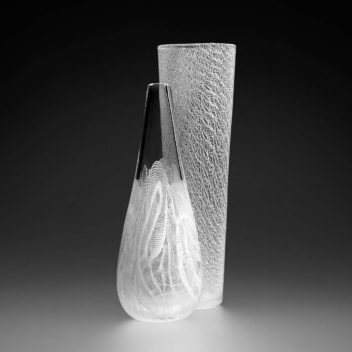
Vetreria Archimede Seguso 1946–
Vetreria Archimede Seguso was founded in 1946 by Archimede Seguso, partner and glassmaster at Seguso Vetri d'Arte until 1942. Seguso was not only the tireless creator of almost all the collections produced by Vetreria Archimede Seguso, he executed his own works and experimented with new techniques and materials. He participated in the Biennali di Venezia and the Triennali di Milano from 1950 on, presenting, among other things, his own personal interpretations of the ancient technique of filigrana. His interpretaions, vessels often enriched with applications of gold leaf, he called Merletti. The company is now run by his son Gino Seguso, with the assistance of his grandson Antonio Seguso.
Archimede SegusoSfumato, 1954
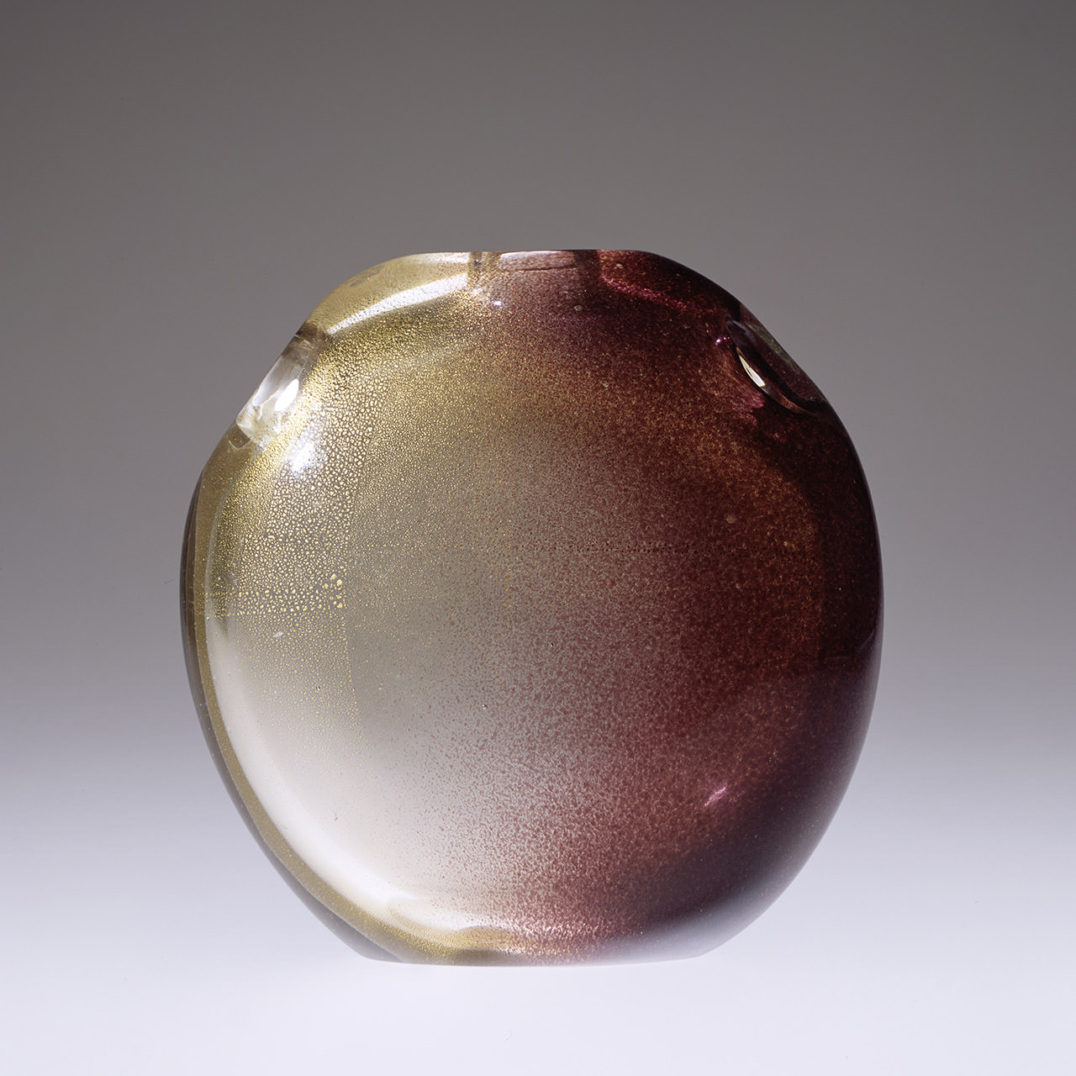
Archimede SegusoPolveri, 1953
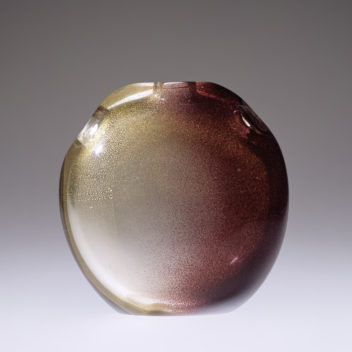
Archimede SegusoPolveriVetreria Archimede Seguso, 1953
A vase with three apertures composed of translucent amethyst glass with inclusions of gold leaf. This vase belongs to the polveri(powders) series.
Acid stamped:
venini murano ITALIA.
Original paper label.
9 in. high (23 cm)
Bibliography and comparative texts:
R. Linzeler, 1922, p. 666;
C. Carrà, 1923, p. 67;
R. Linzeler, 1923, p. 83;
R. Papini, 1930, n. 570;
G. Mariacher, 1967, p. 98;
R. Barovier Mentasti, 1982, n. 252;
Mille anni…, 1982, n. 503;
F. Deboni, 1984, p. n. 70;
W. Neuwirth, 1987, nn. 7, 104;
A. Dorigato, 1986, p. 71;
F. Deboni, 1989, n. 1;
L’arte del vetro, 1982, n. 307;
M. Heiremans, 1993, n. 191;
M. Barovier, R. Barovier Mentasti,
A. Dorigato, 1995, n. 15;
A. Venini Diaz de Santillana, 1996, n. 1;
R. Barovier Mentasti, 1998, n. 25;
A. Venini Diaz de Santillana, 2000, n. 1;
Olnick Spanu, 2000, n. 8;
Olnick Spanu, 2001, n. 13.

Archimede Seguso 1909–1999
Born on Murano and the son of the maestro Antonio Seguso, Archimede Seguso began work at a very early age in the Vetreria Artistica Barovier, where his father was a partner. In 1933, he was one of the founding partners of the Artistica Vetreria e Soffieria Barovier Seguso & Ferro, which was later to become the Seguso Vetri d'Arte. Here, Archimede worked asmaestro of the principal team crafting the pieces designed by Flavio Poli, and later his own pieces inspired by the Novecento style. He sold his share of the workshop to his partners and, in 1946, founded a new workshop, the Vetreria Artistica Archimede Seguso, where he was first maestro and creator of almost all the works produced there. The first glass pieces were still inspired by the Novecento, as were his sculptures modeled in hot glass; at the same time he experimented with thin blown glass textured in many ways, adapting ancient decorative techniques to the styles of the '50s such as, for example, the variations of filigrana that he presented throughout the decade (Merletti, Composizione Lattimo, Piume, etc.). During the '60s and '70s, he created intensely colored glass works such as the colori sovrapposti and the fasce sovrapposte, and further pushed the filigrana technique with his Spinati, and a petali glass pieces. Later on, he based his production on strong contrasting colors. Among his last works is the series of sculptures called Rotture, conceived as original works and made in solid massiccio sommerso glass, a realization of the profound reflections of this artist who later died on the island of Murano.

Vetreria Archimede Seguso 1946–
Vetreria Archimede Seguso was founded in 1946 by Archimede Seguso, partner and glassmaster at Seguso Vetri d'Arte until 1942. Seguso was not only the tireless creator of almost all the collections produced by Vetreria Archimede Seguso, he executed his own works and experimented with new techniques and materials. He participated in the Biennali di Venezia and the Triennali di Milano from 1950 on, presenting, among other things, his own personal interpretations of the ancient technique of filigrana. His interpretaions, vessels often enriched with applications of gold leaf, he called Merletti. The company is now run by his son Gino Seguso, with the assistance of his grandson Antonio Seguso.